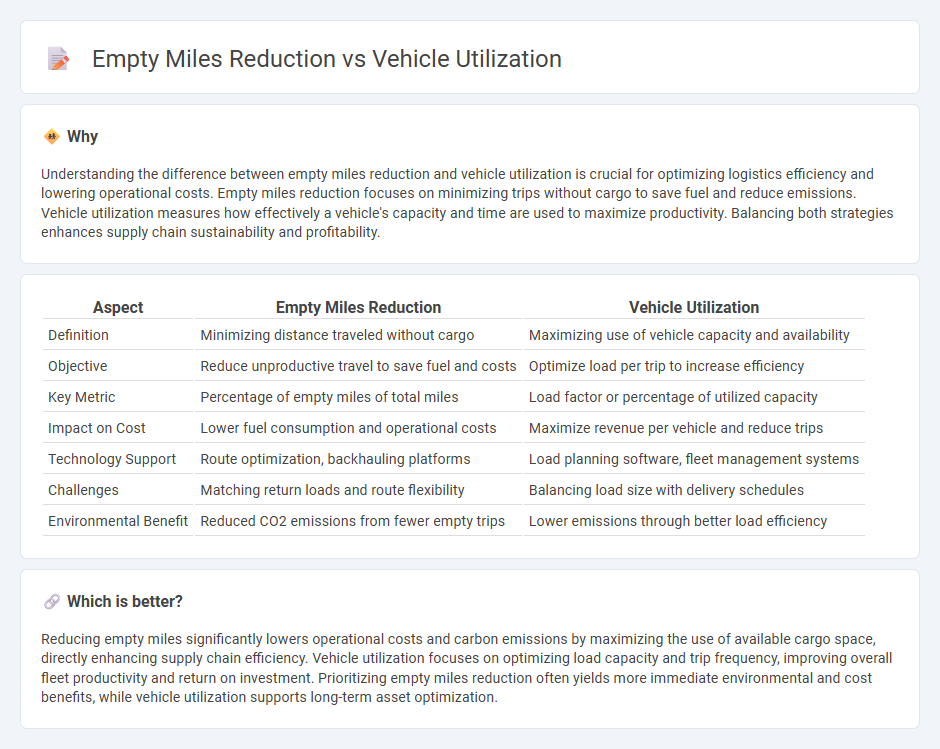
Reducing empty miles in logistics directly improves vehicle utilization by maximizing the capacity of transport assets and minimizing unproductive travel. Effective strategies for empty miles reduction include load consolidation, backhaul optimization, and real-time route planning that align shipments to available capacity. Explore advanced solutions and technologies to understand how empty miles reduction can drive operational efficiency and cost savings.
Why it is important
Understanding the difference between empty miles reduction and vehicle utilization is crucial for optimizing logistics efficiency and lowering operational costs. Empty miles reduction focuses on minimizing trips without cargo to save fuel and reduce emissions. Vehicle utilization measures how effectively a vehicle's capacity and time are used to maximize productivity. Balancing both strategies enhances supply chain sustainability and profitability.
Comparison Table
| Aspect | Empty Miles Reduction | Vehicle Utilization |
|---|---|---|
| Definition | Minimizing distance traveled without cargo | Maximizing use of vehicle capacity and availability |
| Objective | Reduce unproductive travel to save fuel and costs | Optimize load per trip to increase efficiency |
| Key Metric | Percentage of empty miles of total miles | Load factor or percentage of utilized capacity |
| Impact on Cost | Lower fuel consumption and operational costs | Maximize revenue per vehicle and reduce trips |
| Technology Support | Route optimization, backhauling platforms | Load planning software, fleet management systems |
| Challenges | Matching return loads and route flexibility | Balancing load size with delivery schedules |
| Environmental Benefit | Reduced CO2 emissions from fewer empty trips | Lower emissions through better load efficiency |
Which is better?
Reducing empty miles significantly lowers operational costs and carbon emissions by maximizing the use of available cargo space, directly enhancing supply chain efficiency. Vehicle utilization focuses on optimizing load capacity and trip frequency, improving overall fleet productivity and return on investment. Prioritizing empty miles reduction often yields more immediate environmental and cost benefits, while vehicle utilization supports long-term asset optimization.
Connection
Reducing empty miles directly enhances vehicle utilization by maximizing the time trucks spend carrying freight rather than traveling empty. Improved route planning and load matching systems decrease the occurrence of empty runs, increasing the efficiency of each trip. Higher vehicle utilization reduces operational costs and lowers carbon emissions, promoting sustainable logistics practices.
Key Terms
Load Optimization
Maximizing vehicle utilization through load optimization directly reduces empty miles, enhancing overall fleet efficiency and cutting operational costs. Advanced route planning and real-time load matching technologies help businesses achieve higher cargo density, minimizing unproductive travel. Explore proven strategies and innovative tools to optimize your fleet's load capacity and drive substantial savings.
Backhauling
Backhauling significantly improves vehicle utilization by maximizing load capacity on return trips, reducing empty miles that contribute to inefficiency and higher operational costs. Efficient backhaul strategies enhance route planning, lower fuel consumption, and decrease carbon emissions, leveraging data analytics and logistics software to identify optimal return loads. Explore how implementing backhauling can transform your fleet's performance and sustainability goals.
Route Planning
Effective route planning directly enhances vehicle utilization by minimizing empty miles, which represent non-revenue generating travel. Optimizing routes through advanced algorithms and real-time data allows fleets to maximize cargo load, reduce fuel consumption, and improve overall operational efficiency. Explore how innovative route planning solutions can transform fleet productivity and drive cost savings.
Source and External Links
Vehicle Utilization: What It Means and Why It Matters - Vehicle utilization measures the effectiveness and productivity of a vehicle fleet, usually expressed as a percentage of time vehicles are in use versus idle, impacting overall cost efficiency, productivity, and environmental footprint.
Vehicle Utilization: What It Means and Why It Matters - It quantifies how constructively a fleet is employed, with higher utilization reflecting better value generation and improved fleet deployment, thereby enhancing customer service and profitability.
Vehicle utilization: How to improve it? - Improving vehicle utilization involves regularly measuring utilization rates and addressing factors such as driver hours, weight limits, route efficiency, and stopping times, often supported by telematics and fleet management software.
 dowidth.com
dowidth.com